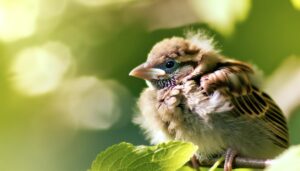How to Identify the Difference Between Male and Female Sparrows
When identifying sparrows, you'll notice males have vibrant plumage with a black bib, white cheeks, and gray cap, while females sport more subdued, brownish tones for better camouflage. Males are generally larger, with body lengths around 15-16 cm and weigh 24-30 grams, compared to females at 14-15 cm and 22-28 grams.
Their beaks differ too; males have darker, robust beaks, while females' are lighter. Male sparrows exhibit bolder wing patterns and produce intricate, louder songs.
Both share similar diets, but males forage openly while females prefer cover. Discovering more will reveal their intriguing nesting and social behaviors.
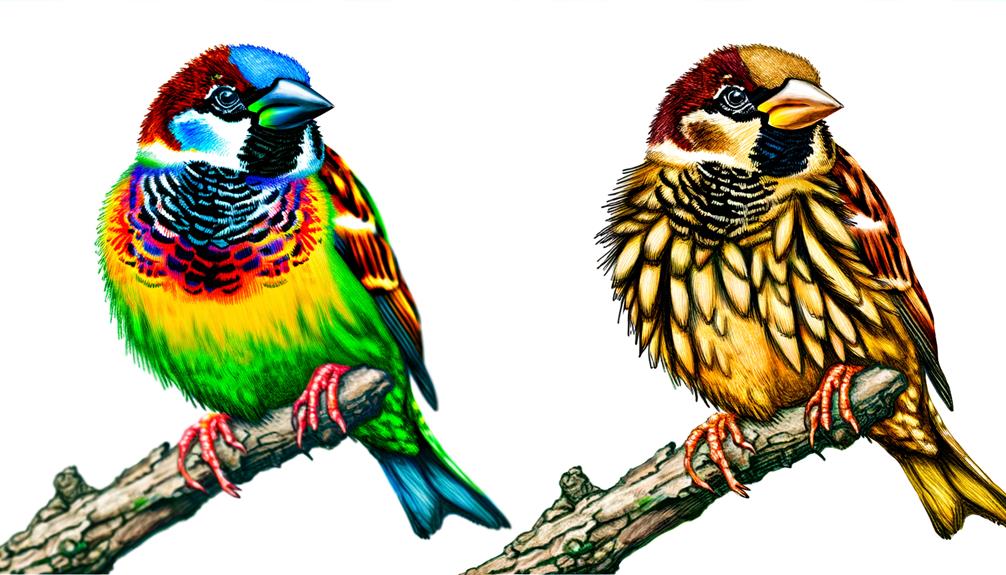
Key Takeaways
- Male sparrows have vibrant plumage with a black bib and gray cap, while females display more subdued, earthy tones.
- Males are larger, with a body length of 15-16 cm, compared to females' 14-15 cm.
- Male sparrows have darker, more robust beaks, whereas females have lighter, slimmer beaks.
- Male sparrows produce intricate, louder songs, while females have subtler vocalizations.
- Males initiate nest building and gather materials, while females focus on refining the nest and brooding.
Physical Appearance
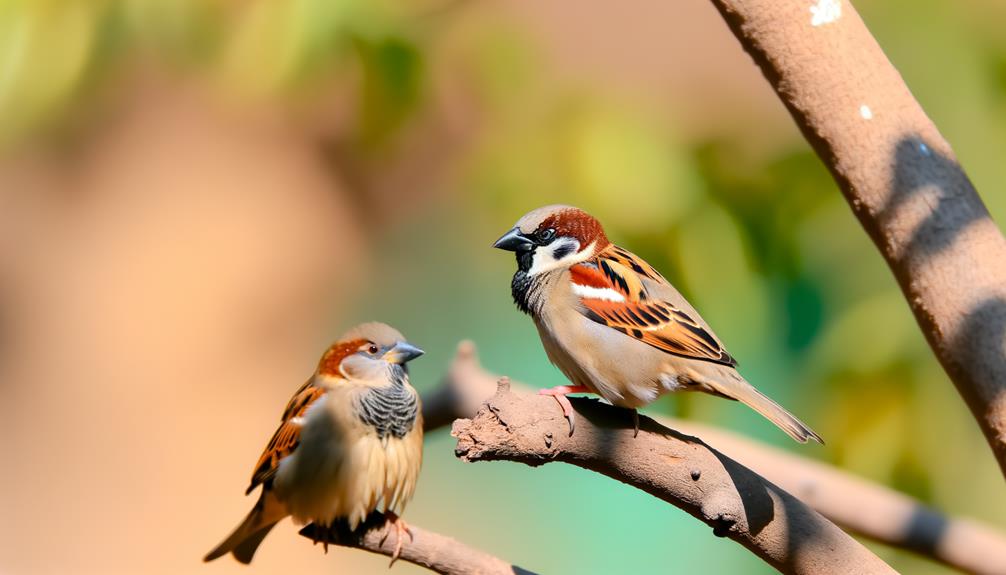
When identifying sparrows, you'll notice that males typically exhibit more vibrant plumage compared to the subtler tones of females. Male sparrows often display distinctive markings, such as bold black bibs and striking white cheeks, which can aid in quick identification.
In contrast, females usually have a more uniform and muted coloration, which provides better camouflage. Additionally, male sparrows tend to have slightly larger and more robust body structures, while females are generally smaller and leaner.
Observing the beak size and shape can also provide clues; males often feature thicker, more pronounced beaks. By focusing on these physical traits, you can better serve bird-watching enthusiasts and contribute to more accurate data collection and conservation efforts.
Plumage Coloration
Male sparrows exhibit vibrant plumage with striking contrasts of black, white, and brown, while females display more subdued, earthy tones. You'll observe that male sparrows have a distinct black bib on their chest and a gray cap on their head, making them noticeable. In contrast, female sparrows have a more uniform, brownish coloration, which aids in better blending with their surroundings.
Here's a quick comparison:
| Feature | Male Sparrow | Female Sparrow |
|---|---|---|
| Head | Gray cap | Brown, lacking a distinct cap |
| Chest | Black bib | Plain brown |
| Back | Striking black and brown streaks | Muted brown streaks |
| Overall Plumage | High contrast | Earthy, toned down |
Recognizing these distinctions guarantees you can recognize and admire each sparrow's individual beauty.
Size Differences
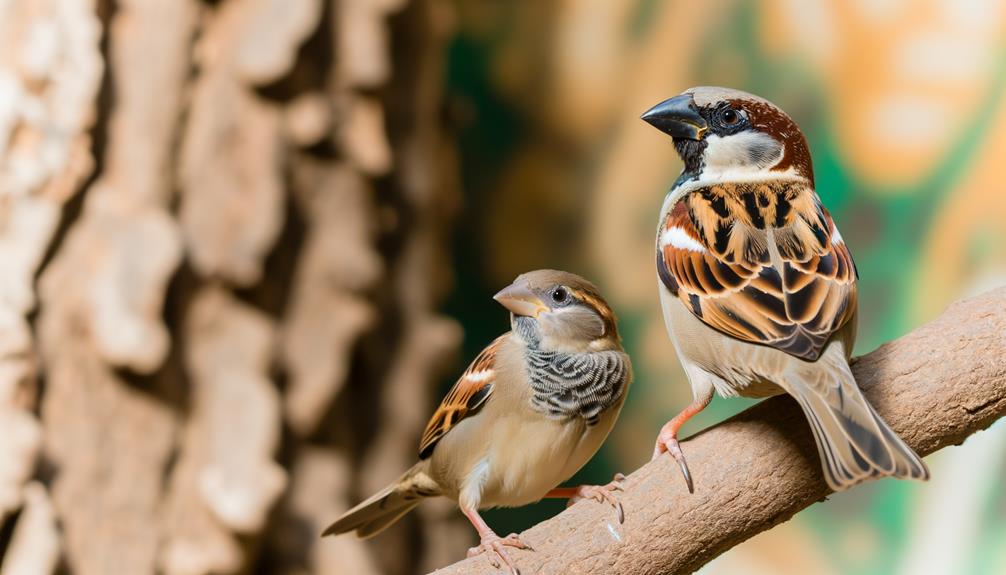
When examining size differences between male and female sparrows, you'll notice variations in body length, weight, and wing span.
Males typically exhibit a slightly longer body length and greater weight compared to females.
Additionally, the wing span of males is generally broader, aiding in more efficient flight.
Body Length Variations
In examining the body length variations between male and female sparrows, you'll notice that males generally exhibit a slightly larger size compared to their female counterparts. Typically, male sparrows measure around 15 to 16 centimeters, while females are slightly smaller, measuring approximately 14 to 15 centimeters.
This difference, though subtle, can be essential for various ecological and behavioral adaptations. For instance, the slightly larger size of males may aid in territorial defense and mate attraction. Understanding these variations can help you in recognizing and protecting these birds more effectively.
Weight Differences
While observing body length differences offers insights, examining the weight variations between male and female sparrows reveals another layer of their physical distinctions.
Typically, male sparrows weigh slightly more than females. On average, a male sparrow's weight ranges from 24 to 30 grams, whereas a female's weight falls between 22 and 28 grams. This difference, although subtle, can be significant when considering their energy requirements and reproductive roles.
The slight extra mass in males often corresponds to their more robust physical activities, such as defending territory. For you, understanding these weight differences can aid in better care practices, ensuring that each sparrow's nutritional needs are met appropriately.
Accurate weight monitoring helps maintain their health and robustness.
Wing Span Comparison
Examining the wing span of sparrows reveals noticeable size differences between males and females, with males generally exhibiting a slightly larger wing span. Male sparrows typically have a wing span ranging from 20 to 22 centimeters, while females usually measure between 19 to 21 centimeters.
This variation, though minor, can influence their flight dynamics and energy expenditure. In your efforts to serve and protect these birds, consider these differences when designing birdhouses or feeders.
A better understanding of their physical characteristics can help you create environments that cater to their specific needs. Such details ensure you provide optimal support, promoting the well-being of both male and female sparrows in their natural habitats.
Beak Characteristics
When examining the beak characteristics of male and female sparrows, you'll notice differences in color and size.
Males typically have darker, more robust beaks compared to the lighter, slimmer beaks of females.
Additionally, both sexes experience seasonal changes in beak coloration, often becoming more pronounced during breeding periods.
Color and Size Differences
Male and female sparrows exhibit distinct differences in their beak color and size. Males typically have darker, more robust beaks compared to the lighter, slender beaks of females. You'll notice that male sparrows' beaks are often a deep, rich hue, which could range from black to dark brown. This contrasts sharply with the females' beaks, which are usually a lighter brown or even a pale yellow.
Additionally, the males' beaks are generally more substantial in size, reflecting their role in competition and territorial defense. Conversely, the females' beaks, while still functional for feeding, are more delicate and finely structured. Observing these characteristics can help you accurately identify the gender of sparrows in the field.
Seasonal Beak Changes
During the breeding season, sparrows' beak colors undergo significant changes. Males display more vibrant and intense hues compared to their non-breeding counterparts. You'll notice that male sparrows exhibit a deeper black coloration on their beaks, which signals their readiness to mate and attract females.
This transformation is driven by hormonal fluctuations that increase melanin production in the beak tissue. In contrast, female sparrows' beak colors remain relatively consistent throughout the year, usually presenting a more subdued, brownish hue.
These seasonal changes in beak coloration are pivotal for mating rituals and social interactions. Understanding these differences can help you identify male and female sparrows more accurately and appreciate the intricate dynamics of their breeding behaviors.
Wing Patterns
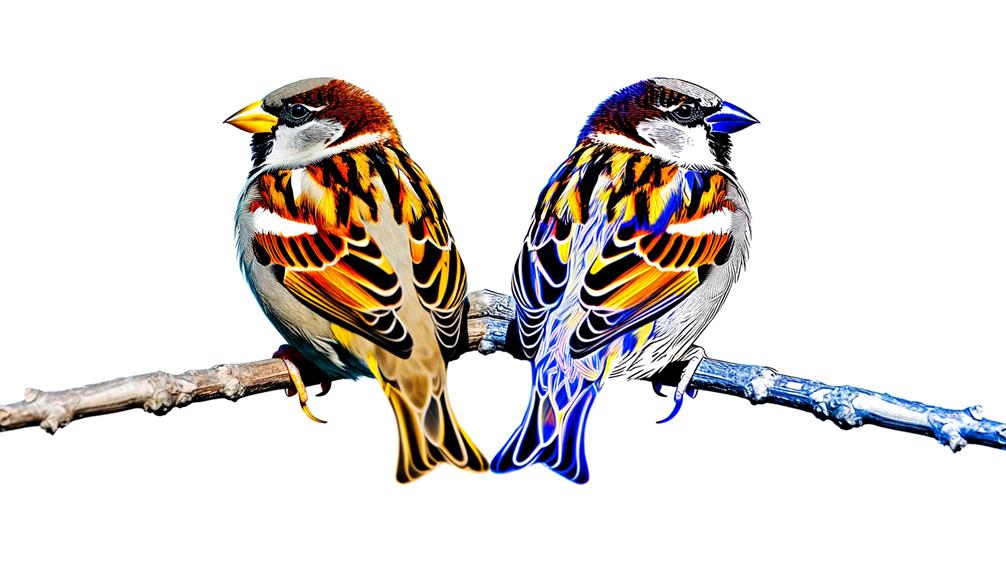
Regarding wing patterns, male sparrows typically exhibit bolder and more distinct markings compared to females, which can aid in identification. You'll notice that males often have black streaks on their wings, creating a more defined and patterned look.
In contrast, female sparrows usually display more subdued and less contrasting wing patterns, often consisting of brown and gray tones that blend together. This difference in wing patterning isn't just for visual appeal but also serves a purpose in mating and camouflage.
When observing sparrows, focus on these subtle distinctions in wing markings to accurately identify the sex. Your keen eye for these details can enhance your bird-watching skills and contribute to citizen science efforts in avian studies.
Tail Markings
In addition to wing patterns, you can distinguish between male and female sparrows by examining the differences in their tail markings. Male sparrows typically have more pronounced and intricate tail markings compared to females.
To assist you in identifying these differences, consider the following characteristics:
- Stripe Patterns: Males often exhibit clearer and more defined stripe patterns on their tail feathers.
- Color Intensity: The coloration of male sparrows' tail markings is generally darker and more vibrant.
- Tail Length: Males tend to have slightly longer tails, aiding in more elaborate marking displays.
- Feather Condition: Males usually have well-maintained tail feathers, while females may appear more worn due to nesting activities.
Observing these traits can help you accurately differentiate between male and female sparrows.
Vocalizations

To differentiate male and female sparrows by their vocalizations, listen closely for the distinct pitch and complexity of their songs. Male sparrows often produce more intricate and varied songs, using them primarily to attract mates and defend their territory. Their vocalizations can be described as louder and more melodious, featuring a wider range of notes and sequences.
In contrast, female sparrows generally emit simpler calls, which are softer and less varied. These calls are usually used for communication within the flock or signaling distress.
Nesting Behavior
When observing nesting behavior, you'll notice distinct roles in nest building between male and female sparrows, with males often initiating the site selection.
Females then take over, refining the nest structure to suit their preferences.
Additionally, both sexes exhibit different patterns in parental care, with females typically investing more in brooding and males in feeding the young.
Nest Building Roles
Male sparrows typically take the lead in nest building by gathering materials, while females focus more on arranging and refining the nest structure. When observing sparrows, you'll notice that their nest-building roles are distinct yet complementary.
Here's what male sparrows do:
- Gather twigs: They collect sturdy twigs to form the nest's outer frame.
- Search for grass: They bring softer grasses and leaves for insulation.
- Retrieve feathers: They find feathers to provide a soft lining.
- Secure the location: They often choose the nesting site and defend it.
Females, on the other hand, meticulously arrange these materials to create a comfortable and secure environment for their eggs and future chicks. This division of labor guarantees an efficient and well-constructed nest, benefiting their offspring's survival.
Mate Selection Preferences
Female sparrows exhibit a keen preference for males who demonstrate superior nest-building skills and territory defense, indicating their potential as reliable partners. You'll notice that females often observe males meticulously as they gather materials and construct nests.
A male's ability to secure a prime nesting site and fend off intruders showcases his competence and resourcefulness. This behavior isn't just about immediate security; it's a signal of genetic fitness and future parental investment.
Parental Care Differences
Sparrows exhibit distinct differences in parental care, particularly in their nesting behavior. Males mainly focus on building and defending the nest, while females concentrate on incubation and feeding the young.
You'll find these behaviors fascinating:
- Nest Building: Males gather materials and construct the nest, ensuring it's secure and suitable.
- Defense: Males vigilantly guard the nest from predators and rival sparrows, ensuring the safety of the eggs and chicks.
- Incubation: Females take on the responsibility of keeping the eggs warm, using their body heat to facilitate proper development.
- Feeding: Once the chicks hatch, females mostly feed them, providing the necessary nutrients for growth.
Feeding Habits
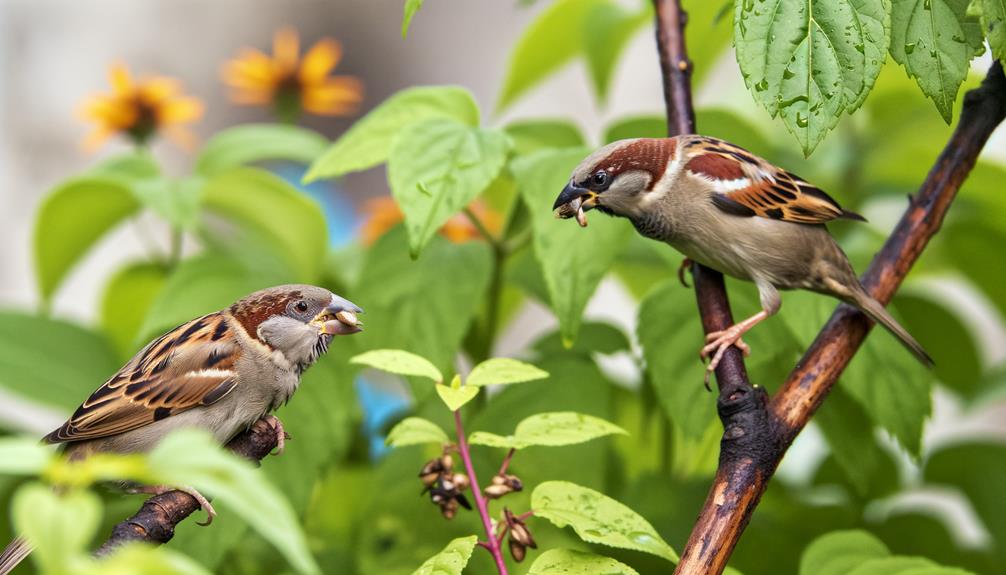
While both sexes of sparrows share a similar diet, subtle differences in their feeding habits can be observed.
Males often forage in more open areas, possibly due to their role in defending territory. You might notice males eating seeds, insects, and grains more frequently in exposed locations.
Females, conversely, tend to feed under cover, likely as a strategy to avoid predators while they're vulnerable, especially during nesting periods. This cautious behavior helps secure they can continue to provide for their young.
Both sexes, however, exhibit resourcefulness by adapting their diet based on availability, showing a remarkable ability to thrive in various environments.
Social Interactions
Observing sparrows' feeding habits also reveals intriguing patterns in their social interactions. You'll notice that male and female sparrows exhibit distinct behaviors in their social dynamics.
Males often establish dominance through vocalizations and territorial displays, whereas females tend to focus on nesting and nurturing activities. Here are some key differences:
- Dominance: Males are more likely to engage in aggressive interactions to assert control over feeding areas.
- Communication: Males use complex songs to communicate, while females primarily use calls for coordination.
- Group Behavior: Males often forage alone or in small groups, whereas females prefer larger, cooperative groups.
- Caregiving: Females invest more time in nurturing young, influencing their social interactions.
Understanding these distinctions helps you support their well-being more effectively.
Seasonal Changes
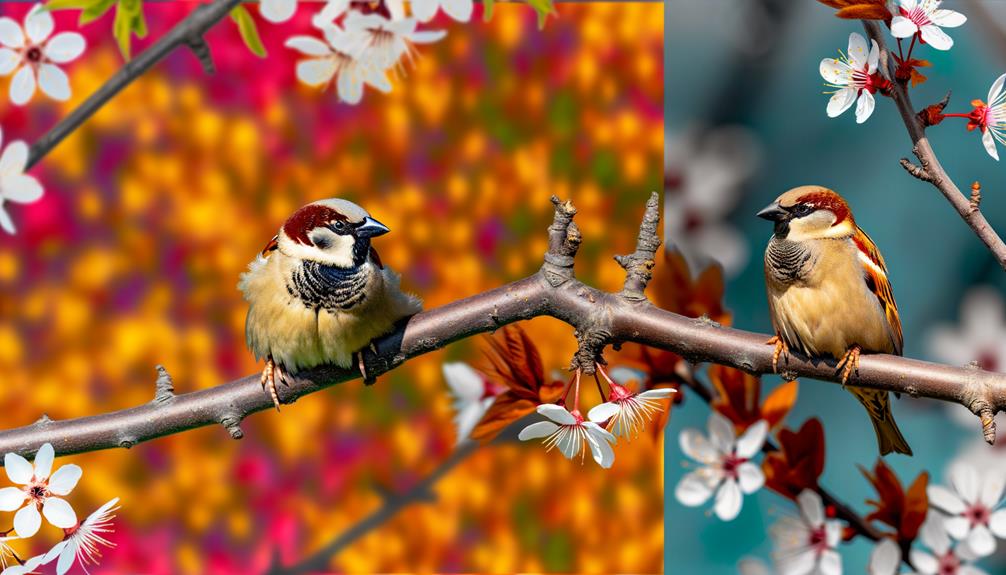
As seasons shift, you'll notice significant changes in the behavior and physiology of male and female sparrows. During spring, males develop brighter plumage to attract mates, while females focus on nest building.
This period also sees an increase in male vocalizations, aimed at securing territory and attracting females. In contrast, females exhibit heightened nesting behavior, preparing for egg-laying.
As autumn approaches, both sexes undergo molting, shedding old feathers for new ones to prepare for winter. Their activity levels decrease, and they shift their focus to foraging and fat storage.
Understanding these seasonal adaptations helps you appreciate the distinct roles each sex plays in ensuring survival and reproduction, ultimately contributing to the species' resilience and continuity.
Conclusion
To conclude, you're now equipped to distinguish male and female sparrows by their physical appearance, plumage coloration, and size differences. Notice their distinct beak characteristics and wing patterns.
Observe their nesting behavior, feeding habits, and social interactions. Pay attention to how these traits may vary with seasonal changes.
By understanding these differences, you're better prepared to appreciate the fascinating complexities of sparrow biology and behavior. Your keen eye and scientific curiosity will deepen your connection to these remarkable birds.

